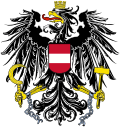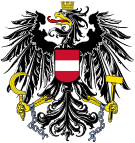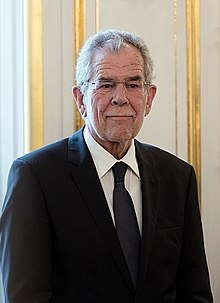| President of Austria | |
|---|---|
| Bundespräsident der Republik Österreich | |
 | |
 | |
since 26 January 2017 | |
| Style | Mr. President His Excellency |
| Type | Head of state |
| Status | Supreme executive organ |
| Member of | Presidential Chancellery |
| Seat | Leopoldine Wing, Hofburg Imperial Palace Innere Stadt, Vienna |
| Nominator | Political parties or self-nomination |
| Appointer | Direct popular vote sworn in by the Federal Assembly |
| Term length | Six years, renewable once |
| Constituting instrument | Constitution of Austria |
| Formation | Creation: 10 November 1920 Restoration: 27 April 1945 |
| First holder | Michael Hainisch |
| Abolished | Anschluss: 13 March 1938 (later restored) |
| Succession | Line of succession |
| Salary | €349,398 annually |
| Website | bundespraesident.at |
| This article is part of a series on the |
| Politics of Austria |
|---|
 |
The president of Austria (German: Bundespräsident der Republik Österreich, lit. 'Federal President of the Republic of Austria') is the head of state of the Republic of Austria.
The office of the president was established in 1920 by the Constituent National Assembly of the first republic following the collapse of the Austro-Hungarian Empire and the Habsburg monarchy in 1918. As head of state, the president indirectly succeeded the emperor of Austria. The power and role of the presidency has varied drastically over time. During the early first republic, the president was an utterly powerless figurehead. In the late first republic, the president received tremendous power but this power was swiftly taken away again following the abrogation of the Constitution and the erection of a corporatist dictatorship in 1934. When Nazi Germany annexed Austria in 1938, the presidency was completely abolished. Following the liberation of Austria by the allied forces in 1945, the republican Constitution was restored and so was the office of the president. Though the president regained the tremendous power they held before the corporatist era, since the second republic, the president voluntarily chose to serve as a ceremonial and symbolic figurehead, allowing the chancellor to become chief executive instead. Since the institution of the popular vote in 1951, only nominees of the Social Democratic Party and the People's Party had been elected to the presidency, with the exception of the Green-endorsed incumbent Alexander Van der Bellen.
The most notable presidential power is the appointment of the chancellor, the vice chancellor and the ministers, which collectively form the Cabinet of Austria. The president also signs bills into law, appoints the justices of the Supreme Courts, signs treaties and exercises various ceremonial duties. Additionally, the president is empowered to remove the chancellor and the Cabinet, dissolve the National Council and the State Legislatures, rule by decree and oversee the Armed Forces but these powers have never or rarely been used. The president ranks first in Austria's order of precedence, ahead of the Presidium of the National Council and the chancellor.
The workplace and official residence of the president is located in the Leopoldine Wing of the Hofburg Imperial Palace in Vienna.


